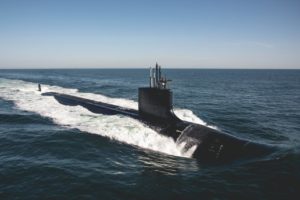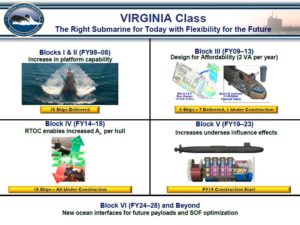The Navy awarded General Dynamics Electric Boat [GD] $22.2 billion in the “largest shipbuilding contract the Navy has ever awarded” for nine Block V Virginia-class attack submarines and an option for a 10th, the Navy’s top acquisition official said on Monday.
The award covers nine submarines, with eight having the Virginia Payload Module (VPM) and all nine having acoustic superiority improvements, James Geurts told reporters at the Pentagon.

The contract includes 10 ship sets of all the supplier material and an option to construct the 10th submarine at any point in the multi-year period. The optional 10th vessel would have the VPM.
“That option we can award any time in the multi-year period. If that option’s awarded, the contract value will exceed $24 billion.”
Block V submarines are being funded by FY 2019 – 2023 accounts and GD started construction of the first ship earlier this year, SSN-802. Deliveries for the Block V are scheduled to last from 2025 through 2029.
The contract announcement noted the total $22.2 billion value includes $3.2 billion previously announced for long-lead-time material and economic ordering quantity material.
SSN-803 will be the first submarine with the VPM. The VPM adds four payload tubes so the submarine can hold up to 28 Tomahawk cruise missiles. It will compensate for the planned retirement of four Ohio-class SSGN guided missile submarines, each equipped with 24 vertical launch tubes with seven missiles each.
The Navy plans to eventually purchase 22 Block V vessels with the VPM to carry about as many missiles as the four SSGNs currently do.
Geurts noted all of the boats will have acoustic superiority upgrades and the VPM is a “significant lethality increase to the boat…and those will ensure we remain the dominant undersea power for the future” in line with National Defense Strategy requirements.
He said a lot of hard work went into figuring out how to construct the contract in a way that balances risk between the government and the shipbuilder and listed possible savings if the vessels are delivered on time.
“If the shipbuilder delivers on target, the multi-year savings…will be 16.5 percent, or $4.4 billion savings to the taxpayer,” Geurts added.
If the shipbuilders build above the target but do not exceed the absolute ceiling the Navy would pay for the vessels, they will still save 6.8 percent, or $1.8 billion due to the multi-year contract. However, Geurts noted the Virginia-class has stayed close or under the target throughout the program, in which case it may hit the $4.4 billion/16.8 percent savings level.

The $22.2 billion figure is contractor material. The nuclear-powered submarines also include significant government furnished equipment (GFE) like the propulsion plants. When adding the GFE, the total program cost raises to about $35 billion for the first nine-10 Block 5 vessels.
When asked why it took over a year to negotiate this contract, Geurts confirmed the 10th boat was made an option to incentivize production timing.
The long negotiation “was so we could both get into a place where we’re comfortable, so getting into a two per year cadence in a way that we could also execute that during Columbia. I think it was a lot of hard work on both sides to get to a place where we had shared risk, shared reward.”
“That’s kind of ultimately why we put one of the boats as an option price, so that we could – as performance warrants, as we see it we can add a 10th boat in there. If not, we can back off a little to make sure Columbia’s successful.”
“This contract allows for our shipbuilding team, our suppliers and our employees to plan ahead so that we can continue to deliver submarines of unmatched quality, stealth and lethality. Increasing the cadence of our production from one per year to two, coupled with the start of full production of the Columbia-class ballistic missile submarine, represents a generational increase in submarine production for our nation. We are prepared to meet that challenge,” Kevin Graney, president of General Dynamics Electric Boat, said in a statement.
While GD Electric Boat is the prime contractor, it and subcontractor Huntington Ingalls Industries’ Newport News Shipbuilding (NNS) generally split the work on Virginia-class boats, with each making certain parts of each vessel and taking turns on building the reactor and performing final assembly.
However, since work on the Columbia-class SSBN nuclear-armed ballistic missile submarine is ramping up at GD Electric Boat, HII will be taking more than 50 percent of the final assembly work in these Block V vessels.
Rear Adm. David Goggins, Program Executive Officer for Submarines, told reporters they are planning to build six of the submarines at Newport News and four at EB, “balancing the workload of Virginia with the Columbia program. So the lead ship of Columbia is the priority for EB at that time, so we made sure that deliveries around lead ship Columbia were being delivered by Newport News.”
Geurts added that the work will still be split by modules, with HII NNS still building bows and sterns of ships while EB builds the modules it normally builds, but with rebalancing final assembly. However, the optional 10th vessel would be the fourth with final assembly at EB.
“We’re just going to lean harder on Newport News for final assembly in this block because EB has got the Columbia production up there,” Geurts said.
Goggins underscored since the first Virginia-class vessels built by both shipbuilders, USS Virginia (SSN-774) and Texas (SSN-775), the Navy and shipbuilders have been able to get through production and the post-shakedown availability faster, cutting 3.5 years total in the process.
For example, he noted the future USS Delaware (SSN-791), had a Board of Inspection and Survey (INSURV) score of .96, “which is pretty phenomenal, so what it’s showing is a continued trend of high-quality ships delivered by both EB and Newport News.”
The first Block V vessel, SSN-803, will have a 70-month build target, then the first VPM submarines for each contractor will have a 74-month target, and the remaining vessels will have a 72-month build target. This is in comparison to the 60-month target for the last Block IV Virginia, with that block currently under construction.
The Defense Department said work will be split between Newport News, Va. (25 percent), Quonset Point, R.I. (21 percent), Groton, Conn. (20 percent), and various other places throughout the U.S.
Work is expected to be finished by August 2029, but if the option for the 10th vessel is exercised, work will extend to February 2030.